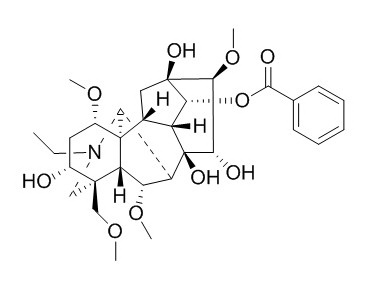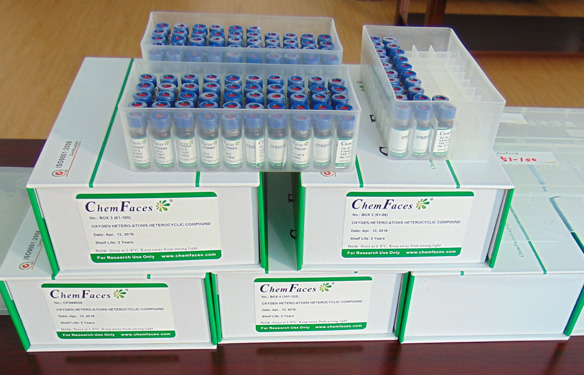Benzoylaconine
Benzoylaconine and aconitine can induce reproductive toxicity in BeWo Cell, the amino acid metabolism was the main metabolic pathway and responsible for the placental and fetal toxicity of them.
Inquire / Order:
manager@chemfaces.com
Technical Inquiries:
service@chemfaces.com
Tel:
+86-27-84237783
Fax:
+86-27-84254680
Address:
1 Building, No. 83, CheCheng Rd., Wuhan Economic and Technological Development Zone, Wuhan, Hubei 430056, PRC
Providing storage is as stated on the product vial and the vial is kept tightly sealed, the product can be stored for up to
24 months(2-8C).
Wherever possible, you should prepare and use solutions on the same day. However, if you need to make up stock solutions in advance, we recommend that you store the solution as aliquots in tightly sealed vials at -20C. Generally, these will be useable for up to two weeks. Before use, and prior to opening the vial we recommend that you allow your product to equilibrate to room temperature for at least 1 hour.
Need more advice on solubility, usage and handling? Please email to: service@chemfaces.com
The packaging of the product may have turned upside down during transportation, resulting in the natural compounds adhering to the neck or cap of the vial. take the vial out of its packaging and gently shake to let the compounds fall to the bottom of the vial. for liquid products, centrifuge at 200-500 RPM to gather the liquid at the bottom of the vial. try to avoid loss or contamination during handling.
The Thai Journal of Pharmaceutical Sciences2023, 47(3):3.
J Neuroinflammation.2023, 20(1):268.
VNU J Science: Med.&Pharm. Sci.2023, 39(2):43-52.
Journal of Third Military Medical University2018, 40(12):1073-1078
Animals (Basel).2024, 14(20):2990.
Molecules.2020, 25(7):1625.
Molecules2022, 27(12):3903.
J Tradit Chin Med.2023, 43(6):1081-1091.
Chemistry of plant raw materials2021, 1:pp 139-150
Drug Des Devel Ther.2020, 14:5189-5204.
Related and Featured Products
Life Sci. 2015 Apr 15;127:66-72.
Multidrug resistance-associated protein 2 is involved in the efflux of Aconitum alkaloids determined by MRP2-MDCKII cells.[Pubmed:
25744397]
Aconitum alkaloids mainly contain highly toxic aconitine (AC), mesaconitine (MA), and hypaconitine (HA) and less toxic Benzoylaconine (BAC), benzoylmesaconine (BMA), benzoylhypaconine (BHA), aconine, mesaconine, and hypaconine. The efflux transporters including P-glycoprotein (P-gp), breast cancer resistance protein (BCRP) and multidrug resistance-associated protein 2 (MRP2) can efflux toxicants to prevent poisoning. Our previous publication has proved that P-gp and BCRP contributed to the efflux of AC, MA and HA, which is demonstrated in the human colonic adenocarcinoma cell lines (Caco-2 cells), Mardin-Darby canine kidney cell lines transfected with MDR1 or BCRP (MDR1-MDCKII and BCRP-MDCKII cells). However, the role of MRP2 remains uncertain.
METHODS AND RESULTS:
The MRP2-MDCKII cells were used to determine the efflux ratios (Er) and intracellular amounts of Aconitum alkaloids. In addition, the importance of MRP2 was further investigated with or without the MRP2 inhibitor, LTC4.
The Er values of AC, MA, HA, BAC, BMA and BHA in MRP2-MDCKII cells (6.4 ± 0.3, 5.9 ± 0.5, 2.2 ± 0.2, 1.6 ± 0.3, 1.7 ± 0.2 and 1.9 ± 0.2 respectively) were significantly higher than those in MDCKII cells, which were close to 1. In the presence of LTC4, the Er values of AC, MA, HA, BAC, BMA and BHA were reduced to approximately 1 and their intracellular amounts were also significantly increased in MRP2-MDCKII cells.
CONCLUSIONS:
MRP2 was involved in the efflux of AC, MA, HA, BAC, BMA and BHA, which would be useful for the safe application of these components or their herbs.
Chinese J. Anal. Chem., 2015, 43(12):1808-13.
Metabolomics Study of Aconitine and Benzoylaconine Induced Reproductive Toxicity in BeWo Cell. [Reference:
WebLink]
An intracellular metabolomics method based on gas chromatography coupled with mass spectrometry (GC-MS) was established to explore the toxicity mechanism of aconitine and Benzoylaconine. BeWo, a continuous cell lines originated from human placenta, was selected to establish in vitro placenta model.
METHODS AND RESULTS:
The intracellular metabolites were extracted after exposed to 5 μg mL−1 aconitine and Benzoylaconine for 0, 6, 12, 24 and 36 h, respectively. The intracellular metabolic profiles were acquired by GC-MS. Orthogonal partial least squares discriminant analysis (OPLS-DA) score plot showed the time-dependent change of the metabolomic profiles between the control and intervention groups. After screening by variable influence on projection (VIP) value and one-way analysis of variance, and searching with NIST 2014 database, 11 metabolites were identified, including proline, glycine, threonine, glutamic acid, N-acetylglutamine, glutamine, lysine, histidine, succinic acid, glucose and galactose, which were mainly involved in the following pathways: (1) glutamine and glutamate metabolism; (2) glycine, serine and threonine metabolism; (3) alanine, aspartate and glutamate metabolism; (4) lysine degradation; (5) arginine and proline metabolism and (6) histidine metabolism.
CONCLUSIONS:
The results demonstrated that amino acid metabolism was the main metabolic pathway and responsible for the placental and fetal toxicity of aconitine and Benzoylaconine.



